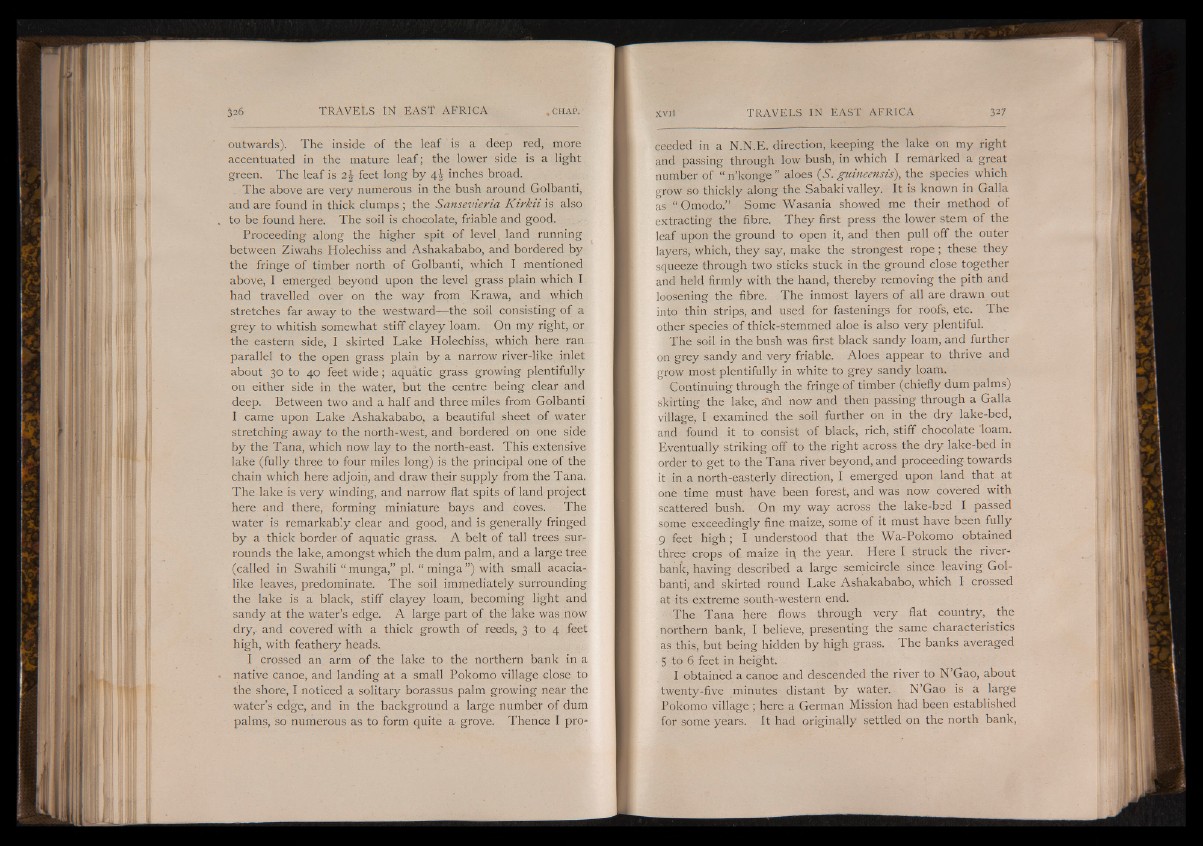
outwards). The inside of the leaf is a deep red, more
accentuated in the mature leaf; the lower side; is a light
green. The leaf is 2\ feet long by 4J inches broad.
The above are very numerous in the bush around Golbanti,
and are found in thick clumps ; the Sansevieria K irk ii is also
to be found here. The soil is chocolate, friable and good.
Proceeding along the higher spit of level, land running
between Ziwahs Holechiss and Ashakababo, and bordered by
the fringe of timber north of Golbanti, which I mentioned
above, I emerged beyond upon the level grass plain which I
had travelled over on the way from Krawa, and which
stretches far away to the westward— the soil consisting of a
grey to whitish somewhat stiff clayey loam. On my right, or
the eastern side, I skirted Lake Holechiss, which here ran
parallel to the open grass plain by a narrow river-like inlet
about 30 to 40 feet wide; aquatic grass growing plentifully
on either side in the water, but the centre being clear and
deep. Between two and a half and three miles from Golbanti
I came upon Lake Ashakababo, a beautiful sheet of water
stretching away to the north-west, and bordered on one side
by the Tana, which now lay to the north-east. This extensive
lake (fully three to four miles long) is the principal one of the
chain which here adjoin, and draw their supply from the Tana.
The lake is very winding, and narrow flat spits of land project
here and there, forming miniature bays and coves. The
water is remarkably clear and good, and is generally fringed
by a thick border of aquatic grass. A belt of tall trees surrounds
the lake, amongst which the dum palm, and a large tree
(called in Swahili “ munga,” pi. “ minga ”) with small acacialike
leaves, predominate. The soil immediately surrounding
the lake is a black, stiff clayey loam, becoming light and
sandy at the water’s edge. A large part of the lake was now
dry,, and covered with a thick growth of reeds, 3 to 4 feet
high, with feathery heads.
I crossed an arm of the lake to the northern bank in a
native canoe, and landing at a small Pokomo village close to
the shore, I noticed a solitary borassus palm growing near the
water’s edge, and in the background a large number of dum
palms, so numerous as to form quite a grove. Thence I proceeded
in a N.N.E. direction, keeping the lake on my right
and passing through low bush, in which I remarked a great
number of | n’konge ” aloes (S. guineensis), the species which
grow so thickly along the Sabaki valley. It is known in Galla
as “ Omodo.” Some Wasania showed me their method of
extracting the fibre. They fiist press the lower stem of the
leaf upon the ground to open it, and then pull off the outer
layers, which, they say, make the strongest rope; these they
squeeze through two sticks stuck in the ground close together
and held firmly with the hand, thereby removing the pith and
loosening the fibre. The inmost layers of all are drawn out
into thin strips, and used for fastenings for roofs, etc. The
other species of thick-stemmed aloe is also very plentiful.
The soil in the bush was first black sandy loam, and further
on grey sandy and very friable. Aloes appear to thrive and
grow most plentifully in white to grey sandy loam.
Continuing through the fringe of timber (chiefly dum palms)
skirting the lake, ind now and then passing through a Galla
village, I examined the soil further on in the dry lake-bed,
and found it to consist of black, rich, stiff chocolate loam.
Eventually striking off to the right across the dry lake-bed in
order to get to the Tana river beyond, and proceeding towards
it in a north-easterly direction, I emerged upon land that at
one time must have been forest, and was now covered with
scattered bush. On my way across the lake-bed I passed
some exceedingly fine maize, some of it must have been fully
9 feet high; I understood that the Wa-Pokomo obtained
three crops o f maize ir\ the year. Here I struck the river-
bank, having described a large semicircle since leaving Golbanti,
and skirted round Lake Ashakababo, which I crossed
at its extreme south-western end.
The Tana here flows through very flat country, the
northern bank, I believe, presenting the same characteristics
as this, but being hidden by high grass. The banks averaged
5 to 6 feet in height.
I obtained a canoe and descended the river to N’Gao, about
twenty-five minutes distant by water. N’Gao is a large
Pokomo village; here a German Mission had been established
for some years. It had originally settled on the north bank,